Chinese Kitemaker Han Fushan's Unique Kites
Blending traditional Chinese kitemaking skills and kite forms with recycled materials, Chinese kitemaker Han Fushan is making some very unique kites.
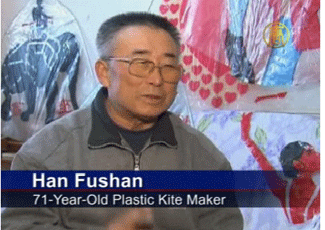 The traditional materials for Chinese kites range from silk and rice paper to fiber made from plants. Split bamboo, which is very flexible, is used for the framing. These materials have been the basis for Chinese kites for hundreds of years.
The traditional materials for Chinese kites range from silk and rice paper to fiber made from plants. Split bamboo, which is very flexible, is used for the framing. These materials have been the basis for Chinese kites for hundreds of years.
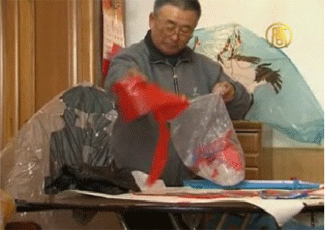 However, Han Fushan is adding a new element to the process: recycled plastic bags in many colours to replace the more expensive silk and rice paper.
However, Han Fushan is adding a new element to the process: recycled plastic bags in many colours to replace the more expensive silk and rice paper.
In a feature story in the November 8, 2009 edition of New Tang Dynasty Television, Han Fushan's kiite making is shown with video of the kite maker and his wonderful creations.
Formerly a construction engineer who worked with architectural drawings, Han turned his skills into a new hobby, kite making, in 2000. To date he has created more than 600 original kites which he flies regularly in a park near his home.
Han's friends are saving bags for him and look forward to viewing his new creations on his daily morning outing in the park. He has gathered a regular following of spectators who sometimes assist him in launching his creations.
Han is a true kite artist and his kites, as shown in the video story on New Tang Dynasty Television, are creative, colourful and noteworthy.

The joy of kite making is evident in the work and the smile of Han Fushan.
Note: check out all the references on this story in the Reference link below. Original credit for the story goes to the Reuters News Agency. Reuters also has the original video on their site.
Francis Rogallo, Father of the Flexible Kite and Hang Glider, dies at age 97
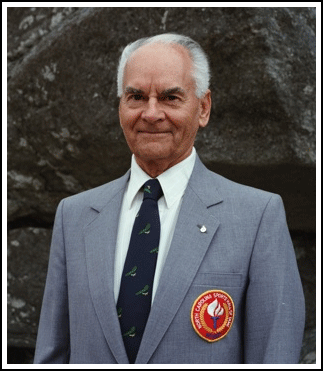 Francis Melvin Rogallo, one of the pioneers of kiting, creator of the innovative Rogallo flexible kite, and acknowledged father of the sport of Hang Gliding died in Southern Shores, North Carolina on Sept. 1, 2009.
Francis Melvin Rogallo, one of the pioneers of kiting, creator of the innovative Rogallo flexible kite, and acknowledged father of the sport of Hang Gliding died in Southern Shores, North Carolina on Sept. 1, 2009.
Mr. Rogallo was born on Jan 27, 1912. He was 97 at the time of his death. He was predeacesed by his wife Gertrude on January 28, 2008.
A release about the career and impact of Mr. Rogallo on the field of aeronautics, kites, and hang gliding was issued by John Harris of the Rogallo Foundation.
Francis Rogallo began his career as an engineer with the National Advisory Committee for Aeronautics (NACA) in 1936. He was an aeronautical engineering graduate of Stanford University (class of 1935).
While working at the NACA1 Langley Research Center in Hampton, Virginia, in the late 1940s, Rogallo developed a concept of an aircraft wing made as a parachute-like flexible structure that would open and maintain its shape by wind pressure. With the help of his wife Gertrude, he made small models that were tested in a rudimentary wind tunnel at their home.
After extensive experimentation and design evolution, he designed the first Rogallo wing which was sewn into a prototype by Gertrude from ordinary kitchen curtain material. The cloth wing was tested on August 15, 1948, and it worked. A patent application was filed on November 23, 1948. On March 20, 1951, Francis and Gertrude were granted a patent (US#2,546,078) for the design of the Rogallo wing.
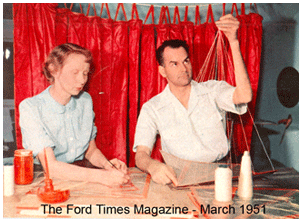
Rogallo often referred to his invention as the "Parawing", but it also came to be known as the Rogallo Wing and the flexible wing.
Writing in Ford Times magazine, March 1951 edition, Rogallo said:
"If we could combine the shape of the supersonic airplane with the unbreakable structure of the parachute we would have a very fine kite indeed. But, for such a kite to fly, it must posess two kinds of stability - stability of shape and stability of position. If we could provide these, the rest would be easy.
We started by making small paper kites and dropping them as gliders. Then we attached threads to them at various points and towed them about the living room. When we found a promising configuration, we built a larger model of cloth and took it to an open field on the shore of Hamption Roads for a trial. If it didn't fly we thought of a way to improve it; so home we went to make the modfications and then back for another trial.
We did our kite research on Saturdays and Sundays when the weather permitted, and on those days trips to the flying grounds were frequent. Our efforts were not in vain, for after many attempts we succeeded in making one of our kites fly. After that taste of success, weekends were not enough. In order to pursue our experiments at night we installed a thirty-six inch fan in our home so that we could test kites in the doorway between two rooms. Many shapes and materials were tested in our wind tunnel and in flight until we had developed a thoroughly satisfactory model."2
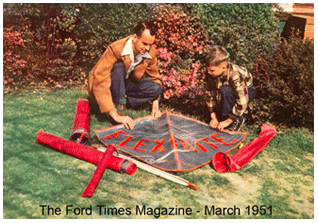
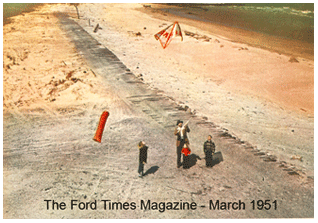
Later, in the same article, Rogallo speculated on the future of his flexible wing by saying:
"Imagine the thrill of carrying such a glider in your knapsack to the top of a hill or mountain and then unfurling it and gliding down into the valley."2
His pondering about the flexible wing was spot on. By the early 1970's sports enthusiasts would add some minor framing and a person carrying harness to the Rogallo wing and the incredible sport of hang gliding was born. Hang gliding captured adventurous fans around the world. Today, hundreds of hang gliders soar off the sand dunes near Kitty Hawk NC very close to where the Rogallos perfected their flexible kite in the late 1940's.
In the early 1960's NASA began experimenting with the Rogallo system during the pioneering days of manned space exploration. NASA actually tested Rogallo wings with payloads up to 6000 pounds3 at altitudes as high as 200,000 feet and as fast as Mach 3 in order to evaluate them as recovery systems for used rocket stages.4 NASA considered using Rogallo's flexible wing as a recovery system for the two man Gemini capsules following their re-entry to the earth's atmosphere. However, the plan was eventually dropped in 1964 in favor of a triple configuration of more standard round parachutes.
 The Rogallo flexible wing design was used in smaller sizes to create kites. Later, in larger scale it was used to lift individuals when towed behind a boat or a vehicle. Innovative individuals soon learned that launching a version of the wing with some rigid framing attached could be achieved by running down a hillside and the sport of hang gliding was created from a modification of the Rogallo wing.
The Rogallo flexible wing design was used in smaller sizes to create kites. Later, in larger scale it was used to lift individuals when towed behind a boat or a vehicle. Innovative individuals soon learned that launching a version of the wing with some rigid framing attached could be achieved by running down a hillside and the sport of hang gliding was created from a modification of the Rogallo wing.
Noted kite historian Tal Streeter leans toward the notion that the Rogallo wing assisted with the development of the modern delta kite5 that is a very popular kite form today.
It is clear that the invention of Francis and Gertrude Rogallo was an important milestone in aeronautic design. The creation of a self-inflating, flexible wing made up of two partial conic surfaces with both cones pointing forward was innovative. It stands today as an amazing achievement in aeronautical engineering.
The following YouTube video clip, originally posted by Canadian "Scare5", shows rare footage of Rogallo testing his flexible kite in an indoor setting. It goes on to show the impetus that the Rogallo flexible kite had on the burgeoning sport of hang gliding. The clip, ten minutes long is of an interview with Francis Rogallo, John Dickenson, and Bill Moyes in 1988. The original source for the clip is a DVD by the Sydney Hang Gliding Centre, http://hanglide.com.au .
UPDATE: December 10, 2022
Research carried out in Australia by long-time hang glider pilot Graeme Henderson has come up with evidence that Francis Rogallo was not the first person to develop the delta wing hang glider. Henderson's research of photographs, documents, and first-person interviews provides clear evidence that on Sept. 8, 1963 John Dickenson made the first flight in what is now considered the modern hang glider.
Based on the NASA flexible wing designed by aeronautical engineer Francis Rogallo, as part of the agency's research on space capsule recovery, Dickensen added a rigid pilot control device beneath the wing and did a successful initial flight on Sept. 8, 1963.
"The pivotal moment for this form of aviation [i.e. hang gliders] was when Mr. Dickenson realized if you put a frame beneath the wing, and made it independent of the wing, then you could control movement around two axis, pitch and roll." - Paul Green, President of the Hang Gliding Federation of Australia.
For additional reading, the article on Earliest Hang Gliders on the hghistory web site traces the history of hang gliding from the work of Leonardo daVinci through the modern era and includes references to and images of the work on the control system by John Dickenson in the early to mid-1960s.
______________
Notes and References:
1. NACA (NationalAdvisory Committee for Aeronautics - March 3, 1915 to Sept. 30, 1958) was the predecessor organization to NASA (National Aeronautics and Space Administration - formed Oct. 1, 1958).
2. "First Flexible Kite" by Francis Rogallo with photographs by Lawrence S. Williams. The Ford Times Magazine, March 1951. Published by the Ford Motor Company, Dearborn MI. Pages 25-29. The quotes are from pages 27-28.
3. Wm. C. Sleeman Jr., NASA-Langley Vehicle Concepts Section, in a letter submitted to Popular Science Magazine, Volume 200, No.5. May 1972, page 10.
4. Wikipedia article on Francis Rogallo.
5. Tal Streeter in "Drachen.Org - Journal -9 (page 3)"
Photo Credits:
- Photo of Francis Rogallo taken in 1987 for his induction into the North Carolina Sports Hall of Fame: Hugh Morton.
- Photographs from The Ford Times Magazine, March 1951 taken by Lawrence S. Williams. No further reproduction or distribution in digital or print form are permitted without the expressed written permission of the Ford Motor Company, Dearborn MI.
Additional Reading:
- Rogallo Photo Gallery at hangglidingspectacular.com
- Meg Robinson's article on Francis Rogallo (click on the Rogallo image at the right)
- The Drachen Foundation: "The Toy Kite That Led to the Hang Glider" by Ben Ruhe, Drachen Journal, Winter 2007-2008, pages 9-10.
- The Drachen Foundation: "The Flexible Happening." by Douwe Jan Joustra, Discourse, April 2009, pages 43-53.
- "How to Fly Without a Plane". Robert Zimmerman at americanheritage.com (Spring 1998, Volume 13 - Issue 4).
Links:
- "Father of Hang Gliding Has Died" (video) - WRAL.com -WRAL-TV, Raleigh-Durham NC. Sept. 3, 2009
- New York Times obituary (Sept. 4, 2009)
- "Father of Hang Gliding Remembered". on All Things Considered, NPR - National Public Radio. (Sept. 7, 2009). Audio recording. Bruce Weaver, a manager at Kitty Hawk Kites Hang Gliding School, is interviewed by program host Guy Raz about remembrances of Francis Rogallo.
Kites Provide Traction Assistance for Adventurers Crossing Greenland
 Kites Support Emirates Greenland Quest
Kites Support Emirates Greenland Quest
Using large power kites to assist their trek across Greenland, a team of three adventurers completed a 4,262 km journey yesterday when they arrived at their finish point at the head of MacCormick Fiord near Qaanaq, Greenland, late Saturday night, July 25, 2009.
Devon McDiarmid and Derek Crowe of Whitehorse in the Yukon, as well as British team leader Adrian Hayes were sponsored by Emirates NBD, the largest financial institution in Dubai. Adrian Hayes works in Dubai and arranged the sponsorship for the amazing expeditions.
The adventurers have a detailed web site outlining the expedition's route, goals, equipment, route and purpose. A blog details some of their adventure as well as the tough work it took to make the trek.
Using the power of the wind to kite ski and haul 150kg sleds for 2 months over what turned out to be a 4,200+ km route that had never been done before. It is possible that the Emirates NBD Greenland Quest is the longest unassisted Arctic Polar journey in history to date.
The group made numerous scientific observations and were concerned with assessing the sustainability of the Arctic ecosystem on Greenland.
The adventureres made a statement on their site that outlines their elation at the conclusion of the trek:
"We've made it! After 67 days and 4262 kms, at 1030 pm Greenland time 25/7, 0030 GMT and, 0430 UAE (26?/7) we arrived at the head of MacCormick Fjord, near to Qaanaq.. Mission accomplished! We're delighted - and can't quite believe its over....
It took 13 hours to cover the final 10-12 kms- the slowest 10km race any of us have ever taken but then the others weren't hauling two sleds over down and around a mountain! If it wasn't so hard it would have been laughable. The sleds - designed to glide on ice - didn't enjoy crashing over rocks quite so much and were totally trashed by the end. No choice unfortunately, its the only way off the ice cap.
But whilst the sleds arrived a little worse for wear, we've arrived safe and well. And healthy..... "
From: http://www.humanedgetech.com/expedition/hayes2/#
The journey and the use of kites makes for interesting reading on their web site and in the following news articles:
- Emirates NBD Greenland Quest official web site.
- CBC: Yukon adventurers complete trek across Greenland.
- Gulfnews.com: Dubai-based explorer Hayes and team complete Greenland quest.
Kites in Pakistan - the kites of Basant in Lahore, Pakistan
The city of Lahore, Pakistan is one of the places where the festival of Basant is observed to welcome spring.
Kites have a long and proud tradition in Pakistan. The following videos explore both the role of kites in the festival of Basant and some of the features of the city of Lahore.
Viewing the following videos, published by Media Concept International, will provide you with insight into the kites and kite flying traditions of Pakistan.
Basant Kite Flying - Part I:
Basant Kite Flying - Part II:
The skill of the kite makers and kite flyers of Pakistan is wonderful to behold. The kite traditions that have endured over several hundred years demonstrate the beauty of the unique kites of Pakistan.
Chinese Kites - Modern Artisans Keep an Ancient Craft Alive
China is considered to be one of the locations of the origin of the kite.
As such, it has a long and varied history of kite craftsmanship that endures into modern times. Even though some news stories out of China have lately lamented the use of modern materials (ripstop nylon sail material and carbon fibre framing) instead of the traditional materials (fine silk or good quality paper sail materials and split bamboo framing), it is clear that the intrinsic value of a finely crafted Chinese kite is still highly desired by kite collectors and those who appreciate kite art.
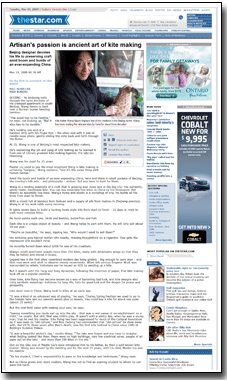 Wang Naixin of Beijing, China is one of a number of incredibly skilled artisans who still produce three-dimensional Chinese kites in traditional ways.
Wang Naixin of Beijing, China is one of a number of incredibly skilled artisans who still produce three-dimensional Chinese kites in traditional ways.
The Toronto Star notes in its Tuesday, May 19, 2009 edition that there is still a demand for such kites, even though they have now become quite pricey (from $50 to $200 US dollars) when they are constructed by a true kite craftsman.
Correspondent Bill Schiller states:
"Wang is a leading exemplar of a craft that is growing ever more rare in the big city: the authentic, whole-made, handmade kite. You can buy assembly-line kites in China by the thousands. But there's no assembly line here: Wang's home and studio is a workshop of one. He builds all his kites from start to finish.
With a closet full of bamboo from Sichuan and a supply of silk from Huzhou in Zhejiang province, Wang is at his work table every morning.
It takes seven days to build a hunting hawk-style kite from start to finish – 21 days or more to craft more complex kites.
He hand-paints each one: birds and beetles, butterflies and fish.
Each kite is a unique object of beauty – and Wang hates to part with them. He will only sell about 10 per year.
"They're so beautiful," he says, sipping tea. "Why would I want to sell them?"
His admiring grey-haired mother sits nearby, drawing thoughtfully on a cigarette. One gets the impression she wouldn't mind.
He recently turned down about $200 for one of his creations."
The Toronto Star article includes a photo of Wang Naixin holding the body of a three dimensional bird kite. It is well worth reading and provides excellent insight into the type of craftsmanship required in traditional Chinese kite making.
Additional Reading:
- Jue, David F. Chinese Kites - How to Make and Fly Them. Charles E. Tuttle Company. Rutland, VT. 1967.
- Kuiming, Ha and Yiqi, Ha. (Trans. Kiggell, Ralph). Chinese Artistic Kites. Commercial Press Ltd. Hong Kong, 1990 (North American edition). ISBN: 0-8351-2279-4
- Chungen, Liu. Chinese Kites. Foreign Language Press, Beijing. 2001. ISBN: 7-119-02669-0
- ________. Origami Tako and Kite. (In Chinese). ISBN: 4-87051-124-X




